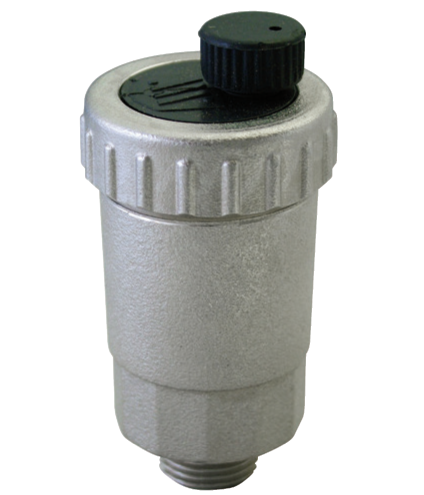Use the automatic air vents on heat sinks.
An aid to the energy efficiency of the heating systems by using the automatic air vents.

To improve the efficiency and operation of radiators and heaters, it is necessary to have air vent valves available. They can be mainly of two types:
- Manual air vent valves: present on most long-standing radiators, they require human intervention by unscrewing a valve.
- Automatic air vent valves: the component is fully automated and does not require the intervention of an external operator.
The real problem behind the manual ones is the lack of efficiency due to delays in opening the valve. In fact, this operation is carried out only when the system becomes noisy or does not guarantee a correct heat flow. This, however, represents only the culmination of a more or less long period of malfunction and suboptimal energy yield.
With automatic air vent valves, this problem is eliminated because, as soon as the device perceives a malfunction, it works in the opposite direction aiming to resolve it almost instantly. This mechanism allows optimal operation both from the point of view of noise and from the energy point of view.
- Manual air vent valves: present on most long-standing radiators, they require human intervention by unscrewing a valve.
- Automatic air vent valves: the component is fully automated and does not require the intervention of an external operator.
The real problem behind the manual ones is the lack of efficiency due to delays in opening the valve. In fact, this operation is carried out only when the system becomes noisy or does not guarantee a correct heat flow. This, however, represents only the culmination of a more or less long period of malfunction and suboptimal energy yield.
With automatic air vent valves, this problem is eliminated because, as soon as the device perceives a malfunction, it works in the opposite direction aiming to resolve it almost instantly. This mechanism allows optimal operation both from the point of view of noise and from the energy point of view.
How does an automatic air vent valve work?
The fundamental components for the operation of an automatic air vent valve are essentially two:
- The float: it is necessary for the automatic reading of the water level and, when it drops below a predefined level, it moves the shutter ensuring the escape of excess air;
- The shutter: it is necessary to open and close the air vent. Subsequently, the closure takes place automatically.
Attention must be paid to the fact that, despite the valve has an automatic operation, the systems still require human intervention for maintenance, control and any fluid refilling through the appropriate tap.
- The float: it is necessary for the automatic reading of the water level and, when it drops below a predefined level, it moves the shutter ensuring the escape of excess air;
- The shutter: it is necessary to open and close the air vent. Subsequently, the closure takes place automatically.
Attention must be paid to the fact that, despite the valve has an automatic operation, the systems still require human intervention for maintenance, control and any fluid refilling through the appropriate tap.
The automatic air vent valves from Gnali Bocia
In addition to the two essential components mentioned above, there are a number of other functional parts to ensure an efficient and long-lasting air release over time.
- Tumbler: made of CW617N brass, excellent for corrosion resistance and with good mechanical properties;
- Lid: made of Hostaform, a type of polyoxymethylene (POM), a material that resists well both at different temperatures and friction and wear;
- Float and moving parts: made of PP, a very common thermoplastic semi-crystalline polymer that has remarkable chemical resistance properties;
- Sealing gasket: made of "anti-sticking" elastomeric material;
- Springs: made of stainless steel.
In addition, to increase the finish, a nickel-plated surface treatment may be necessary which guarantees excellent resistance properties to aggressive environments and fluids, such as the water conveyed in the system. The maximum guaranteed temperatures are around 100 ° C while the maximum pressures are 10 bar.
- Tumbler: made of CW617N brass, excellent for corrosion resistance and with good mechanical properties;
- Lid: made of Hostaform, a type of polyoxymethylene (POM), a material that resists well both at different temperatures and friction and wear;
- Float and moving parts: made of PP, a very common thermoplastic semi-crystalline polymer that has remarkable chemical resistance properties;
- Sealing gasket: made of "anti-sticking" elastomeric material;
- Springs: made of stainless steel.
In addition, to increase the finish, a nickel-plated surface treatment may be necessary which guarantees excellent resistance properties to aggressive environments and fluids, such as the water conveyed in the system. The maximum guaranteed temperatures are around 100 ° C while the maximum pressures are 10 bar.
27/07/2020
I contenuti di questo sito non hanno carattere di periodicità e non rappresentano 'prodotto editoriale'.









